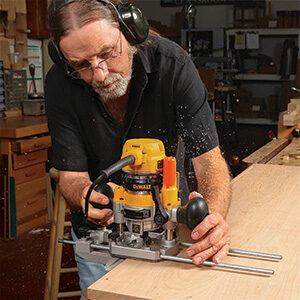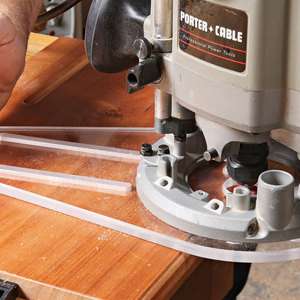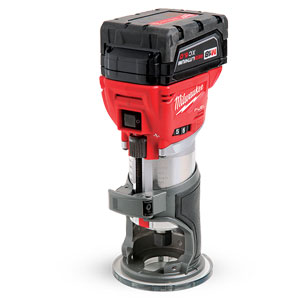I’ve known for a long time that peak horsepower ratings tell you very little about a motor. But the router I bought this past weekend brought home that point in a striking way. The box it came in touted the router as a 3 1/2 horsepower monster. For some reason, I don’t really know why, I decided to go back and reread a short piece by Barry Wixey in Fine Woodworking #175 about universal motors. Wixey explains that there is a difference between peak horsepower and continuous horsepower. Peak horsepower is a sharp spike that the motor can’t maintain, but continuous horsepower is the power it works at under normal conditions. There is a big difference between the two.
Here’s how to calculate continuous horsepower. Multiply the motor’s amp rating by the number of volts being feed into the motor to get the watts output. For my router that would be 15×120=1800. Divide the result by 746 (the number of watts in one horsepower). 1800/746 = 2.41. That’s right, my 3 1/2 horsepower router is capable of putting out 2.41 horsepower on a continuous basis.
But wait, there’s more. That 2.41 is possible only if the motor is 100% efficient, not loosing any mechanical power to heat or other wastes. Well, a typical universal motor is between 65% and 75% efficient. So, my 3 1/2 horsepower router is really outputting between 1.56 and 1.80 horsepower continuously.
That might upset you, and I was a little peeved. But then I remembered, every router I’ve used has been more than capable of doing what I asked of it. So I’m not too worried about the somewhat misleading horsepower claims. The router will do the job.
By the way, the best way to get a sense of a motor’s power is to look at its amp rating. Ignore peak horsepower claims entirely. For more on horsepower, read Martin Seifert’s article in Fine Woodworking #135.























Comments
I think you forgot about the effiency. That same article says that 20-30% loss is typical so lets use 25% loss or 75% efficient and calculate again
2.41 HP x 75% = 1.8 HP out!
As long as we are talking effiency, did you ever wonder why it costs so much to heat a house with electicity? The electric grid loses about 50% and power plants are 40% efficient in converting energy in fuel into mechanical power so generating + distribution are only 20% efficient. Compare that to a gas furnace which may be 90% efficient at turning fuel into heat.
So, your 1.8 HP (net) router takes 12 HP worth of fuel to run. This comparison is not strictly correct but you get the idea why we have global warming.
Efficiency does drive me mad, but I did mention it. Check the third to last paragraph. What I need is a solar powered router.
A lot of things are said about electric AC motors and I am peeved by all the misunderstanding of such a common item, the small AC motor used in tools and other domestic devices.
Here is a few things to add to the dicussion:
If a manufacturer specify a Max Hp then there should be a duty cycle defined. If one would exceed the duty cycle at Max Hp then the motor would overheat. ( some motor have overheat protection built in (my table saw)
Power Factor or PF ( see this link for a good explanation http://en.wikipedia.org/wiki/Power_factor ) PF is lousy in small AC motors of all types. A perfect motor would have a
PF of 1 it is not unusual to see power factor of 0.75 this has nothing to do with efficiency. It has to do with the induction of the winding in the motor.
If one were to add the power factor to the power calculation
we end up with 3 different values
Apparent Power = Volt x Current = the unit is VA not Watts
Real Power = Volt x Current x PF = Watts
Reactive power = apparent power - real power
Your electric meters measures Real Power so you don't have to pay for PF and reactive power Just remember that if the spec. of your motor says VA it is not the same as Watt.
Electrical motor are very efficient normally over 95% and the loses are only heat in the windings and friction in the bushings. The motor could be made 99.9% efficient by using bigger wire in the windings and replacing bushing with bearings. That motor would be heavy, very large and expensive.
The maximum HP you can draw from a 15A 125v outlett is.
Apparent power= 15A x 125V= 1875VA
Real power = 1875VA x 0.75PF = 1406.25Watts *
HP= 1406W/746 HP per Watt = 1.9 HP
Anything higher would trip the breaker or blow the fuse,
A 2HP motor would trip the breaker after 10 minutes at full load and a 3.5 HP motor would trip the breaker after 10 seconds ( value taken from the trip curves of a Qo type breaker )
* Many electrical code state that a 15A 125V circuit(sum of all the outlets)should not be loaded to more than 1200Watts
Log in or create an account to post a comment.
Sign up Log in